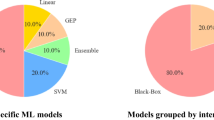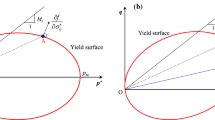Abstract
Determining soil resilient modulus for pavement design traditionally involves resource-intensive repeated load triaxial testing, prompting the need for a reliable and efficient prediction model. While previous research studies have explored evolutionary algorithms and genetic programming to create closed-form models, a significant gap exists in incorporating freezing–thawing cycles, a vital yet neglected factor affecting resilient modulus. This study addresses this gap by leveraging a comprehensive dataset of 1111 data points and introducing a novel explicit closed-form prediction equation. Utilizing the offspring selection genetic algorithm (OSGA), the proposed model not only demonstrates high accuracy, with a coefficient of determination (R2) = 0.93 and mean absolute error (MAE) of 6.54 MPa for the training set and R2 = 0.92 and MAE = 6.91 MPa for the testing set, but also surpasses traditional black-box machine learning models by its interpretability, transparently, and the possibly of using it in routine designs. Additionally, sensitivity analysis revealed that freezing–thawing cycle count is the most influential parameter, followed by the weighted plasticity index and water content.





Similar content being viewed by others
Data Availability
The data used in the paper are available upon request from the corresponding author.
References
Affenzeller, M., Wagner, S.: Offspring selection: a new self-adaptive selection scheme for genetic algorithms. In: Ribeiro, B., Albrecht, R.F., Dobnikar, A., Pearson, D.W., Steele, N.C. (eds.) Adaptive and Natural Computing Algorithms. Springer, Vienna (2005). https://doi.org/10.1007/3-211-27389-1_52
Azam, A., Bardhan, A., Kaloop, M.R., Samui, P., Alanazi, F., Alzara, M., Yosri, A.M.: Modeling resilient modulus of subgrade soils using LSSVM optimized with swarm intelligence algorithms. Sci. Rep. 12, 1445 (2022). https://doi.org/10.1038/s41598-022-17429-z
Cao, Z., Wang, Y.: Bayesian model comparison and characterization of undrained shear strength. J. Geotech. Geoenviron. Eng. 140(6), 04014018 (2014)
Coleri, E.: Relationship between resilient modulus and soil index properties of unbound materials. MS thesis. Department of Civil and Environmental Engineering, Middle East Technical University, Ankara, Turkey (2007)
George, K.: Prediction of resilient modulus from soil index properties. Washington, D.C: No. FHWA/MS-DOT-RD-04–172, University of Mississippi (2004)
Ghorbani, A., Hasanzadehshooiili, H., Ghamari, E., Medzvieckas, J.: Comprehensive three dimensional finite element analysis, parametric study and sensitivity analysis on the seismic performance of soil–micropile-superstructure interaction. Soil Dyn. Earthq. Eng. 58, 21–36 (2014)
Gudishala, R.: Development of resilient modulus prediction models for base and subgrade pavement layers from in situ devices test results. Thesis M.SLouisiana State University and Agricultural and Mechanical College (2004)
Hanittinan, W.: Resilient modulus prediction using neural network algorithms. The Ohio State University, Ohio (2007)
Hardcastle, J.: Subgrade resilient modulus for idaho pavements. Idaho Department of Transportation, Idaho (1992)
Hashim, S., Al-Mosawe, H., Mohammed, H.: The influence of using recycled asphalt pavement and crumbed rubber on asphalt pavement: a review. Al-Nahrain J. Eng. Sci. 26(2), 74–82 (2023)
Hassan, A.B.: The effects of material parameters on Dynamic Cone Penetrometer results for fine-grained soils and granular materials. Oklahoma: Oklahoma State University Stillwater (1996)
Herath, A., Mohammad, L., Gaspard, K., Gudishala, R., Abu-Farsakh, M.: The use of dynamic cone penetrometer to predict resilient modulus of subgrade soils. Adv. pavement Eng., Austin, Texas, United States: Geotechnical Special Publication ASCE, Reston 1–16 (2005). https://doi.org/10.1061/40776(155)2
James, G., Witten, D., Hastie, T., Tibshirani, R.: An Introduction to Statistical Learning, Book, 2nd edn. 103 (2013)
Kardani, N., Aminpour, M., Raja, M.N.A., Kumar, G., Bardhan, A., Nazem, M.: Prediction of the resilient modulus of compacted subgrade soils using ensemble machine learning methods. Transp Geotech 36, 100827 (2022). https://doi.org/10.1016/j.trgeo.2022.100827. (ISSN 2214-3912)
Khasawneh, M.A., Al-jamal, N.F.: Modeling resilient modulus of fine-grained materials using different statistical techniques. Transp. Geotech. 21(3), 100263 (2019)
Langdon, W.B., Poli, R., McPhee, N.F., Koza, J.R.: “Genetic programming: an introduction and tutorial, with a survey of techniques and applications,” Studies in Computational Intelligence. Springer (2008)
Lee, W., Bohra, N.C., White, T.D., Altschaeffl, A.G.: Resilient modulus of cohesive soils. J. Geotech. Geoenviron. Eng. 132(2), 131–136 (1997)
Liu, S., Zou, H., Cai, G., Bheemasetti, T.V., Puppala, A.J., Lin, J.: Multivariate correlation among resilient modulus and cone penetration test parameters of cohesive subgrade soils. Eng. Geol. 209, 128–142 (2016). https://doi.org/10.1016/j.enggeo.2016.05.018
Malla, R.B., Joshi, S.: Subgrade resilient modulus prediction models for coarse and fine-grained soils based on long-term pavement performance data. Int. J Pavement Eng. 9(6) (2008). https://doi.org/10.1080/10298430802279835 (page range)
Mohammad, L.N., Titi, H.H., Herath, A.: Evaluation of resilient modulus of subgrade soil by cone penetration test. Transp. Res. Rec. 1, 236–245 (1999). https://doi.org/10.3141/1652-30
Mohammad, L.N., Herath, A., Abu-Farsakh, M.Y., Gaspard, K., Gudishala, R.: Prediction of resilient modulus of cohesive subgrade soils from dynamic cone penetrometer test parameters. J. Mater. Civ. Eng. 19, 986–992 (2007). https://doi.org/10.1061/(asce)0899-1561(2007)19:11(986)
Pal, M., Deswal, S.: Extreme learning machine-based modeling of resilient modulus of subgrade soils. Geotech. Geol. Eng. 32, 287–296 (2014). https://doi.org/10.1007/s10706-013-9710-y
Poli, R., Langdon, W.B., McPhee, N.F.: A field guide to genetic programming. Lulu Enterprises Ltd., UK (2008). freely available at http://www.gp-field-guide.org.uk
Sadik, L.: Develo** prediction equations for soil resilient modulus using evolutionary machine learning. Transp. Infrastruct. Geotech. (2023). https://doi.org/10.1007/s40515-023-00342-x
Sadik, L., Khoshnevisan, S.: “Simplicity vs complexity in machine learning models – focusing on soil resilient modulus prediction”, in Geo-Congress 2024. Vancouver, BC (2024)
Sadrossadat, E., Heidaripanah, A., Osouli, S.: Prediction of the resilient modulus of flexible pavement subgrade soils using adaptive neuro-fuzzy inference systems. Constr. Build. Mater. 123, 235–247 (2016). https://doi.org/10.1016/j.conbuildmat.2016.07.008
Sadrossadat, E., Heidaripanah, A., Ghorbani, B.: Towards application of linear genetic programming for indirect estimation of the resilient modulus of pavements subgrade soils. Road Mater. Pavement Des. 19(1), 139–153 (2016b). https://doi.org/10.1080/14680629.2016.1250665
Santha, B. L.: Resilient modulus of subgrade soils: comparison of two constitutive equations. Transportation Research Record, 1462, Office of Materials and Research, Georgia Department of Transportation, 15 Kennedy Drive, Forest Park, GA 30050 (1994). Available online: http://worldcat.org/isbn/0309060680
Thi Hoang, H.-G., Nguyen, T.-A.: ‘An artificial intelligence approach to predict the resilient modulus of subgrade pavement or unbound material,” In: 6th International Conference on Geotechnics. Civil Engineering and Structures 203, 1755–1763 (2021)
Tokar, A., Johnson, P.: Rainfall-runoff modeling using artificial neural networks. J. Hydrol. Eng. 4(3), 232–239 (1999). https://doi.org/10.1061/(ASCE)1084-0699
Willis, M.J., Hiden, H., Marenbach, P., McKay, B., Montague, G.: Genetic programming: an introduction and survey of applications. Genetic ALgorithms in Engineering Systems: Innovations And Applications, Glasgow, 314–319 (1997). https://doi.org/10.1049/cp:19971199
Zhao, T., Song, C., Lu, S., Xu, L.: Prediction of uniaxial compressive strength using fully Bayesian Gaussian process regression (fB-GPR) with model class selection. Rock Mech Rock Eng 55, 6301–6319 (2022). https://doi.org/10.1007/s00603-022-02964-y
Author information
Authors and Affiliations
Contributions
L.S.: modeling, conceptualization, and write-up. D.A.: review, writing, and visualization. S.A.: review and writing original draft. M.A.Q.A.: writing and review. S.K.: editing, visualization, and review. All authors have read and agreed to the published version of the manuscript.
Corresponding author
Ethics declarations
Competing Interests
The authors declare no competing interests.
Additional information
Publisher's Note
Springer Nature remains neutral with regard to jurisdictional claims in published maps and institutional affiliations.
Rights and permissions
Springer Nature or its licensor (e.g. a society or other partner) holds exclusive rights to this article under a publishing agreement with the author(s) or other rightsholder(s); author self-archiving of the accepted manuscript version of this article is solely governed by the terms of such publishing agreement and applicable law.
About this article
Cite this article
Sadik, L., Al-Jeznawi, D., Alzabeebee, S. et al. An Explicit Model for Soil Resilient Modulus Incorporating Freezing–Thawing Cycles Through Offspring Selection Genetic Algorithm (OSGA). Transp. Infrastruct. Geotech. (2024). https://doi.org/10.1007/s40515-024-00399-2
Accepted:
Published:
DOI: https://doi.org/10.1007/s40515-024-00399-2




